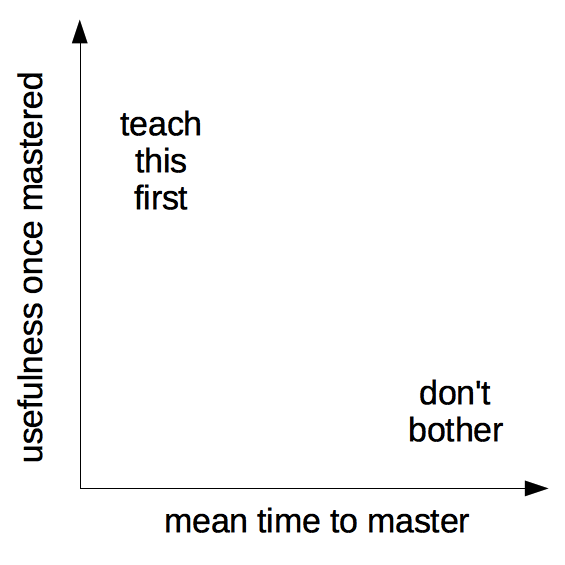Motivation and demotivation
Gerard Capes
Overview
- Motivation is the best predictor of learning, and this episode covers typical ways learners are motivated, and how they can be demotivated.
- Situation we’re often dealing with:
- Most scientists just want to do science, and view programming as a ‘tax’.
- Early programming experiences often demoralising.
Creating a positive learning environment
- Is important for learner success
- Crucial to establish workshop as safe space for learning
- Present instructor as learner: OK to make mistakes (live coding)
- Establish norms for interaction: code of conduct, taking turns in discussions
- Acknowledge material is challenging, and their misunderstandings are valid
Teach most useful first
- People learn best when they care about a topic and believe they can master it.
- Aim to teach something they think is useful in first 15 mins.
- Something they can apply to their work
- Also builds confidence in us for later episodes, if the useful bit takes longer to get to
- ‘Authentic tasks’ will be highly motivating

Exercise: Authentic tasks
- Think about some task you did this week that uses one or more of the skills we teach, (e.g. wrote a function, bulk downloaded data, built a plot in R, forked a repo) and explain how you would use it (or a simplified version of it) as an exercise or example in class.
- Pair up with your neighbor and decide where this exercise fits on a graph of “short/long time to master” and “low/high usefulness”.
- In the class shared document, share the task and where it fits on the graph. As a group, we will discuss how these relate back to our “teach most immediately useful first” approach.
This exercise and discussion should take about 10 minutes.
Motivation strategies
- Connect the material to students’ interests
- Provide authentic, real-world tasks
- Show relevance to students’ current academic lives
- Demonstrate the relevance of higher-level skills to students’ future professional lives
- Identify and reward what you value
- Show your own passion and enthusiasm for the discipline
Exercise
Strategies for motivating learners
- Discuss ideas from the list in the shared document, and describe how they can be applied in our workshops
Exercise
Brainstorm motivational strategies
- Think back to a computational (or other) course you took in the past, and identify one thing the instructor did that motivated you.
- Pair up with your neighbour and discuss what motivated you.
- Share the motivational story in the shared document.
This exercise should take about 5 minutes.
Demotivation
- Motivation can go both ways - don’t crush their enthusiasm!
- No-one intends to demotivate, but it’s easy to do accidentally.
Exercise
Brainstorming demotivational experiences
- Think back to a time when you were demotivated as a student (or when you demotivated a student).
- Pair up with your neighbour and discuss what could have been done differently in the situation to make it not demotivating.
- Share your story in the shared document.
This exercise should take about 5 minutes.
Demotivators
- Unfairness and indifference
- Other things not to do:
- Be scornful of any tool e.g. Excel, Word, GUI applications
- By association, learners will feel like you’re criticizing them
- Dive into complex discussion with 1 or 2 people
- Pretend to know more than you do
- Use the J word (just)
- Feign surprise
- Be scornful of any tool e.g. Excel, Word, GUI applications
Stereotype threat
Self-confirming belief that one may be evaluated based on a negative stereotype
- Anxiety about confirming those stereotypes can reduce performance
- Don’t remind people of negative stereotypes
- “I’m so glad you’re here because we don’t get enough women in programming.”
- Never learn alone
- Get people to sign up in groups
Imposter syndrome

Dealing with imposter syndrome
- Ask for feedback from someone you trust, and believe it!
Learn from role models
- Academics are particularly susceptible (isolated working, public results)
- Share stories of your mistakes and struggles
- It’s OK to find things difficult!
Emphasise that you want questions
Accessibility
- Unequal access to lessons is demotivating!
- e.g. screen readers unable to read images
- Not always possible to accommodate everyone, but can have a structure in place
- Do easy things first, gives confidence other concerns will be addressed
- e.g. font, text size, room access
- Accessibility measures help everyone
- e.g. curb cuts, image captioning
Exercise: Learning about accessibility
The UK Home Office has put together a set of posters of dos and don’ts for making visual and web-based materials more accessible for different populations. Take a look at one of these posters and put one thing you’ve learned in the shared document.
This exercise should take about 5 minutes.
Inclusivity
- Policy of including people who might otherwise be marginalised
- e.g. women, people of colour, LGBT, disabled
- Making a positive effort to be more welcoming to those groups
- Make notes free of gendered pronouns, use culturally diverse names
- Emphasise the rate of learning is important, not their starting point
- Encourage pair programming
Code of conduct
- Sets expectations for participation
- Just the fact it exists tells people something about our values
- “Be excellent to each other”
Key points
- A positive learning environment helps people concentrate on learning.
- People learn best when they see the utility in what they’re learning, so teach what’s most immediately useful first.
- Imposter syndrome is a powerful force, but can be overcome.
- Accessibility benefits everyone.